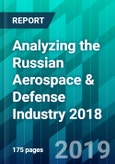At the end of 2018, the Russian Defense Minister put out a major announcement stating a major revamp of the Russian aerospace and defense industry in 2019. It was announced that the Russian defense and aerospace sector will be getting 143 new aircraft, their first S-350 Vityaz surface-to-air complex, and two regiments of S-400 Triumf air defense missile systems. There are also plans to get seven battalion sets of the Pantsyr air defense missile/gun systems. It is expected that in the coming years, the share of modern and upgraded weaponry, military and specialized hardware will reach 65% in the Russian air force and up to 81.8% in the country's aerospace force.
Russia remains a country with tremendous market potential for the aerospace and defense industry services. After decades of restrictions on traveling abroad during the Soviet period, many Russians are now using the opportunity to travel extensively on business and as tourists in ever-increasing numbers. In order to cater to this demand, the Russian aerospace and defense industry needs to overcome the current crisis and develop an improved aviation infrastructure.
As the Russian aerospace and defense industry consolidates, it is integrating more and more into the world market. The most important factors are:
- Dramatic decrease in domestic defense orders
- Decrease in acquisition potential of the Russian air carriers following the collapse of Aeroflot monopoly
- Absence of a well-organized leasing system
- Significant reduction in state investments into research and development
- Certification of foreign aircraft that opened the way to upgrade the Russian fleet with Western aircraft
Analyzing the Russian Aerospace and Defense Industry 2018 provides a well-grounded research analysis of the Russian Aerospace and Defense Industry. This report aims to help investors and analysts understand the emergence of the Russian Aerospace and Defense Industry. Giving an overview of the industry including the latest developments and acquirements, market statistics, looking at the issues and challenges faced by the industry, the report explores all the facets of the Russian Aerospace and Defense Industry.
The leading players, their products, and their role in Russia’s Aerospace and Defense Industry are all described in details in Analyzing the Russian Aerospace and Defense Industry 2018 research report. An in-depth analysis of the Sukhoi company and its various products of strategic military importance makes this research report different from the others available today.
Table of Contents
A. Executive Summary
Companies Mentioned
- Aeroflot Russian Airlines
- S7 Airlines
- Sukhoi
- Volga-Dnepr








